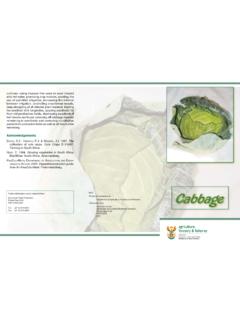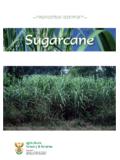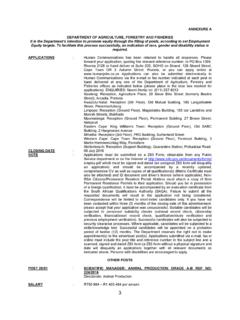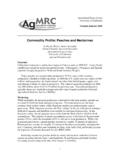Transcription of PRODUCTION GUIDELINE
1 PRODUCTION GUIDELINE . agriculture, forestry & fisheries Department: Agriculture, Forestry and Fisheries REPUBLIC OF SOUTH AFRICA A. PRODUCTION GUIDELINE . March 2013. Directorate: Plant PRODUCTION Department of Agriculture, Forestry and Fisheries 2013. Published by Department of Agriculture, Forestry and Fisheries Design and layout by Directorate Communication Services Private Bag X144, Pretoria 0001. Disclaimer This document has been compiled by the Department of Agriculture, Forestry and Fisheries and every effort has been made to ensure the accuracy and thoroughness of the information contained herein and the department cannot be held responsible for any errors, omissions or inaccuracies in such information and data, whether inadvertent or otherwise. The Department of Agriculture, Forestry and Fisheries therefore accepts no liability that can be incurred resulting from the use of this information. Contents Part 1: General aspects 1.
2 Classification 1. 2. Origin and distribution 1. 3. PRODUCTION levels 1. 4. Major PRODUCTION areas in South Africa 2. 5. Cultivars 2. 6. Description 3. 7. Climatic requirements 4. 8. Soil requirements 5. Part 2: Cultivation practices 1. Propagation 5. 2. Soil preparation 5. 3. Planting 5. 4. Fertilisation 6. 5. Irrigation 8. 6. Weed control 8. 7. Pest control 9. 8. Disease control 10. 9. Other cultivation practices 10. 10. Harvesting 11. Part 3: Post-harvest handling 1. Sorting 11. 2. Post-harvest handling 12. 3. Grading 12. 4. Packaging 13. 5. Storage 14. 6. Marketing 14. Part 4: PRODUCTION schedule 15. Part 5: Utilisation 15. Part 6: References 15. PART I: GENERAL ASPECTS. 1. Classification Scientific name: Litchi chinensis Family: Sapindacea Common names: Litchi 2. Origin and distribution The litchi is indigenous to a small subtropical area in the south of China. Literature reveals that litchi trees were imported into South Africa from Mauritius in 1876, but some trees had already been noticed in Natal (now KwaZulu-Natal) in 1875, which indicates earlier imports.
3 Different cultivars were established in Natal and later in the former Transvaal (now Mpuma- langa Province) Lowveld and other suitable frost-free areas of the country. These trees were brought to the Lowveld (Barberton area) by one Todd by ox-wagon more than 100 years ago and planted on the property Litchi Farm, where they continue to yield constant, satisfactory crops. 3. PRODUCTION levels South Africa The litchi industry in South Africa is well established and exhibits a slow, yet rising trend with regard to new plantings and PRODUCTION . The present PRODUCTION in South Africa is approximately 18 000 tons per annum during a good season; most of this is being sold locally, as fresh fruit, on the Johan- nesburg market. The export potential for litchi is good. There is great demand for the fruit in England, while the European market is still not exploited. Depending on the local market prices and season, about 1 000. tons are exported annually.
4 Internationally Most of the world litchi crop is produced in the East (China and India). PRODUCTION in India is 92 000 tons, of which 2 000 are exported. Litchis from the East are exported to Western countries mainly in a preserved form, or as dried litchis (litchi nuts). Of the Western countries where litchis are produced, South Africa is the biggest and marketing possibilities are good, because the fruit is exported during Christmas and New Year when there is a great demand for exotic fruit. 1. 4. Major PRODUCTION areas in South Africa Province PRODUCTION areas Mpumalanga Mbombela Malelane Limpopo Trichardtsdal Tzaneen Louis Trichardt (Makhado). Levubu 5. Cultivars The choice of cultivars is based on quality, adaptability and reliability, susceptibility to diseases and pests, plant growth and habit, the specific market and planting time. Name of cultivar Characteristics Mauritius group This group is the most frequently planted, both locally and abroad.
5 The cultivars produce satisfactory yields and fruit of good quality. Cultivars include HLH Mauritius, Hazipur, Late Large Red, Muzaffarpur, Rose-Scented and Saharan. Chinese group Cultivars in this group do not produce as large yields as the Mauritius group, but the fruit is of excellent quality and has a high percentage of chicken-tongue seeds. Cultivars include Haak Yip, Kontand, Glutinous Rice, Shang Shou Haui, and Three Months Red. 2. Name of cultivar Characteristics Madras group These trees bear very colourful red fruit, but the fruit quality is not as good as the fruit quality of the other two groups. The fruit flesh is soft and watery and the seed is large. The trees also tend to al- ternate bearing. Cultivars in this group are Bedana, Brewster, Durbhanga, Em- merson, Hazipur, Johnstone's Favorite, Kafri, McLean's Red, Madras 19, Ma- ries, Mooragusha and Shorts Seedless 6. Description Mature plant The litchi tree is attractive, dense, round-topped, slow-growing, 9 to 30 m high and equally broad.
6 Roots Litchi has a strong taproot and some spreading in surface. Leave The leaves are evergreen, 12, 5 to 20 cm long, are pinnate, having 4 to 8. alternate, elliptic-oblong to lancelet, abruptly pointed leaflets, somewhat leathery, smooth, glossy, dark green on the upper surface and greyish-green beneath, and 5 to 7,5 cm long. Flowers The tiny petals, greenish-white to yellowish flowers are borne in terminal clusters to 75 cm long. Pollination Through faulty pollination, many fruit have shrunken, only partially developed seeds (called chicken tongue ) and such fruit are prized because of the greater proportion of flesh. In a few days, the fruit naturally dehydrates, the skin turns brown and brittle and the flesh becomes dry, shrivelled, dark brown and raisin like, richer and somewhat musky in flavour. Because of the firmness of the shell of the dried fruits, they came to be nicknamed litchi, 3. nuts by the uninitiated, and this erroneous name has led to much misunder- standing of the nature of this highly desirable fruit.
7 It is definitely not a nut , and the seed is inedible. Seed There is much variation in the size and form of the seed. Normally, it is oblong, up to 20 mm long, hard, with a shiny, dark-brown coat and is white internally. Essential part Fruits are in loose, pendent clusters of 2 to 30 are usually strawberry-red, sometimes rose, pinkish or amber, and some types tinged with green. Most are aromatic, oval, heart-shaped or nearly round, about 2,5 cm wide and 4. cm long; have a thin, leathery, rough or minutely warty skin, flexible and easily peeled when fresh. Immediately beneath the skin of some varieties is a small volume of clear, delicious juice. The glossy, succulent, thick, translucent-white to greyish or pinkish fleshy aril, which usually separates readily from the seed, suggests a large, luscious grape. The flavour of the flesh is sub-acid and distinctive. 7. Climatic requirements Temperature Litchis grow best in a subtropical climate with high summer temperatures, low and frost-free winter temperatures.
8 Low winter temperatures are essential for bringing about the necessary physiological changes to stimulate flower initiation. Temperatures of below 0 0C can cause damage on flowers and young shoots. The frost-free areas of South Africa with a high summer rainfall and humidity (especially the Mpumalanga Lowveld, the Soutpansberg area and the KwaZulu-Natal coastal area) are therefore most suitable. For successful litchi PRODUCTION , the climate must comply with the following: The average monthly maximum temperature during summer must be below 32 0C, but above 26 0C. The average monthly minimum temperature must be above 6 0C, but less than 14 0C for the 3 to 4 winter months The relative humidity from October to fruit maturing must be more than 50%. 4. Water In litchi PRODUCTION , high summer rainfall promotes maximum fruit growth and yield. Adequate water must be available from flowering until the fruit can be harvested, that is from August to January.
9 Sufficient soil moisture must be available during the flowering period and for 7 to 8 weeks after flowering because this is the most important period of fruit set and the start of cell division in the young fruitlet, especially in the skin and the young embryo (seed). 8. Soil requirements Litchis grow well on sandy soils in the cooler subtropical areas of South Africa. A huge network of fine roots has been observed up to a depth of 4 m in such soils. However, the trees also grow and produce on clayey soils, but have a shallower root distribution. The crop is therefore well adapted to various soil types. PART II: CULTIVATION PRACTICES. 1. Propagation Propagation is by means of air-layers that are made during August and which are cut off in January or February. Optimum root growth of the air-layer is obtained during the summer months. 2. Soil preparation Soil testing is very important before planting in order to determine the soil pH.
10 And the availability of excess deficiency of macro and micro elements in the soil. Phosphorus is a serious problem in South African soil, so it is important to check if the levels of phosphorus and potassium are adequate. Normally, if there is a shortage in application of lime and fertilisers as recommended from the soil test result, it is advisable to cultivate phosphorus and lime in the soil because they move very slowly. 3. Planting Grafted trees or trees developed from air-layers are ready for planting after the required breeding period in the lath-house or in the shade. Litchi trees can be planted at any time of the year, but the spring months or the onset of the rainy season would be the best time. It is advisable to dig the planting holes in advance and about twice as deep as the container in which the 5. trees were bought. The topsoil can be mixed with compost in the hole to create a favourable medium for good root development.














